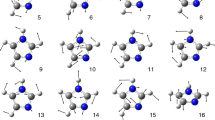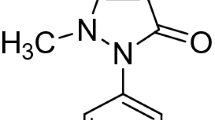Abstract
Purpose
In the present investigation metal (II) complexes containing binuclear Co (II), mono nuclear Ni (II), and Cu (II) with ligand 2E-N-phenyl-2-[([1,3]thiazolo[3,2-a]benzimidazol-2yl) methylidene]hydrazine-1-carbothioamide moiety were synthesized in ethanolic medium, recrystallized and investigated for their biological properties. The carbothioamide was derived from the reaction of benzo [4, 5] imidazo [2, 1-b] thiazole-2-carbaldehyde and 4-phenyl-3-thiosemicarbazide at reflux temperature.
Methods
The newly formed compounds were characterized by 1H-nuclear magnetic resonance (1H-NMR), 13C-nuclear magnetic resonance (13C-NMR), Fourier transformed infrared spectroscopy (FT-IR), ESR spectroscopic techniques and elemental analysis. Ligand containing “O” and “S” donor atoms participated in coordination with metal (II) complexes and are confirmed by FT-IR, electronic absorption spectra, 1H-NMR data. DNA binding properties of these metal complexes were investigated by ESR, magnetic moments and electronic absorption spectroscopy.
Results
Antibacterial studies, DNA binding constants of the complexes indicated intercalative binding mode involving strong aromatic chromophoric groups and base pairs of DNA. All the complexes (2a, 2b and 2c) showed intercalative binding with DNA and DNA cleavage was studied in presence and absence of H2O2 which was observed for copper (II) complex.
Conclusion
Antibacterial study results showed that cobalt complex inhibit the growth of Staphylococcus epidermis, Bacillus subtilis, Pseudomonas aeruginosa and Escherichia coli with MIC values of 7.98 µg/mL, 8.12 µg/mL, 7.34 µg/mL, and 7.56 µg/mL respectively. Metal (II) complexes exhibit higher antibacterial activity than the parent ligand.






Similar content being viewed by others
References
Amico JJD (1966) US patent 3:225059. Chem Abstr 64:8193
Bagihalli GB, Avaji PG, Patil SA, Badami PS (2008) Synthesis, Spectral Characterization, in Vitro Antibacterial, Antifungal and Cytotoxic Activities of Co (II), Ni (II) and Cu(II) Complexes With 1, 2, 4-triazole Schiff Bases. Eur J Med Chem 43(12):2639–2649
Bauer W, Kirby MM, Am J (1966) Antibiotic Susceptibility Testing by a Standardized Single Disk Method. Am J Clin Pathol 45:493–496 (PMID: 5325707)
Benesi HA, Hildebrand JH (1949) A Spectrophotometric Investigation of the Interaction of Iodine with Aromatic Hydrocarbons. J Am Chem Soc 71(8):2703–2707
Boas JF, Dunhill RH, Pilbrow JR, Srivastava RC, Smith TD (1969) Electron spin resonance studies of copper (II) hydroxy-carboxylic acid chelates in aqueous and non-aqueous solutions. J Chem Soc (A): 94–108.
Brown TA (1990) Ancient DNA: Using molecular biology to explore the past. A Pract Approach 1:51–52
Charles Jr. S, Smith SH, Drach JC, Klayman DL (1981) Antiviral Activity of 2-Acetylpyridine Thiosemicarbazones against Herpes Simplex Virus. Antimicrob Agents Chemother 19(4):682–685
de Oliveira RB, de Souza-Fagundes EM, Rodrigo PP, Anderson AA, Antoniana UK, Carlos LZ (2008) synthesis and antimalarial activity of semicarbazone and thiosemicarbazone derivatives. Eur J Med Chem 9(43):1983–1988
Dobek AS, Klayman DL, Dickson ET, Scovill JP, Tramont EC (1980) inhibition of clinically significant bacterial organisms in vitro by 2-acetylpyridine thiosemicarbazones. Antimicrob Agents Chemother 18:27–36
Emara B, El-Sayed AES (2008) Syntheses, spectroscopic characterization and thermal behavior on novel binuclear transition metal complexes of hydrazones derived from 4,6-diacetylresorcinol and oxalyldihydrazine. Spectrochim Acta A 69:757–769
Ertas M, Sahin Z, Emre FB, Bender C, Biltekin NB, Berk B, Yurttas L, Nalbur AM, Celik H, Demirayak S (2019) Potent ribonucleotide reductase inhibitors: Thiazole-containing thiosemicarbazone derivatives. Arch Pharm Chem Life Sci. https://doi.org/10.1002/ardp.201900033
Eugene-Osoikhia TT, Badmus TO, Ayeni F (2020) Synthesis, characterization and antimicrobial studies of metal (II) complexes of ofloxacin and metronidazole. Chem Search Journal 11(1):74–82
Finches RL, Alburn HE, Schreck PA, Bloom R, Gregory FJ (1980) Immunomodulating and antimetastatic activity of 3-(p-clorophenyl) thiazolo [3,2-a]benzeimidazole-2-acetic acid. J Immunopharmacol 2:491–508
Giordano RS, Bereman RD, Kosman DJ, Ettinger MJ (1974) Stereo electronic properties of metalloenzymes. II. Effects of ligand coordination on the electron spin resonance spectrum of galactose oxidase as a probe of structure and function. J Am Chem Soc 96(4):1019–1023
Hathaway J (1984) A new look at the stereochemistry and electronic properties of complexes of the copper (II) ion. Struct Bond 57:55–118
Hasegawa G, Kotani A (1975) Jap Patent 74: 95 997. Chem Abstr 82:156299
Itahana H, Fujiyasu J, Hayashibe S, Watanabe T, Okada M, Toya T US7250429B2(2007) US 10/508:329.
Jeyasubramanian K, Samath SA, Thambidurai S, Murugesan R, Ramalingam SK (1996) Cyclicvoltammetric and ESR studies of a tetraaza 14-membered macrocyclic copper (II) complex derived from 3-salicylidene-acetylacetone and o-phenylenediamine: stabilization and activation of unusual oxidation states. Transit Metal Chem 20(1):76–80
Kailas HK, Sheetal JP, Anita PP, Apoorva HP (2016) four synthesis methods of Schiff base ligands and preparation of their metal complex with Ir and antimicrobial investigation. World J Pharm Pharm Sci 5(2):1055–1063
Karki SS, Kuppusamy P, Sujeet K, Nambiar M, Suresh B, Ramareddy A, Chiruvella KK, Raghavan SC (2011) Synthesis and biological evaluation of novel 2-aralkyl-5-substituted-6-(4′-fluorophenyl)-imidazo [2,1-b][1, 3,4] thiadiazole derivatives as potent anticancer agents. Eur J Med Chem 46(6):2109–2116
Kivelson D, Neiman R (1961) ESR Studies on the Bonding in Copper Complexes. J Chem Phys 35:149–155
Kung A, Pieper T, Wissiack R, Rosenberg E, Keppler KB (2001) Hydrolysis of the tumor-inhibiting ruthenium (III) complexes HIm trans-[RuCl4(im)2] and Hindtrans-[RuCl4(ind)2] investigated by means of HPCE and HPLC-MS. J Biol Inorg Chem 6:292–299
Li Y, Yang YZ, Wang FM (2010) synthesis, characterization, DNA binding properties: fluorescence studies and antioxidant activity of transition metal complexes with hesperetin-2-hydroxy benzoyl hydrazine. J Fluoresc 20:891–905. https://doi.org/10.1007/s10895-010-0635-z
Lv LL, Xia MW, Cheng ZY, Zhang PL, Wang DX (2019) synthesis, structure, DNA binding and anticancer activity of a new tetra nuclear Pb (II) complex constructed by 8-hydroxyquinolinate and 4-nitrobenzoate ligands. Main Group Met Chem 42:60–66
Maki AH, McGreevy BR (1958) ESR studies on the bonding in copper complexes. J Chem Phys 29:31–35
Manimaran A, Jayabalakrishnan C (2012) DNA-binding, catalytic oxidation, CC coupling reactions and antibacterial activities of binuclear Ru (II) thiosemicarbazone complexes: Synthesis and spectral characterization. J Adv Res 3:233–243
Margarita LT, Fernandez A, Fernandez JJ, Suarez A, Pereira MT, Ortigueira JM, José MV, Adams H (2001) mono and di nuclear five-coordinate cyclometalated palladium (II) compounds. Inorg Chem 40(18):4583–4587
Muhammad S, Ali SA, Badshah A (2013) Drug–DNA interactions and their study by UV–Visible, fluorescence spectroscopies and cyclic voltammetry. J Photoch Photobio B: Biology 124:1011–1344. https://doi.org/10.1016/j.jphotobiol.2013.03.013
Murray RP, Baron EJ, Pfaller MA, Tenover FC, Yolke HR (1995) Manual of Clinical Microbiology, A S M, Washington, D C, USA.Grard M J (1930) Compt. Rend 190:187–189
Noolvi MN, Patel HM, Singh N, Gadad AK, Cameotra SS, Badiger A (2011) Synthesis and Anticancer Evaluation of Novel 2-cyclopropylimidazo[2,1-b][1,3,4]-thiadiazole Derivatives. Eur J Med Chem 46(9):4411–4418
Ommenya KF, Nyawade AE, Andala MD, Kinyua J (2020) synthesis, characterization and antibacterial activity of Schiff base, 4-chloro-2-{(E)-[(4 fluorophenyl)imino]methyl}phenol Metal (II) complexes. J Chem Article ID. https://doi.org/10.1155/2020/1745236
Parker S, Touchette E, Oberle C, Almond M, Robertson A, Trost LC, Lampert B, Painter GR, Buller RM (2008) Efficacy of therapeutic intervention with an oral ether-lipid analogue of cidofovir (CMX001) in a lethal mousepox model. Antiviral Res 77:39–49
Perin N, Nhili R, Cindric M, Bertosa B, Vusak D, Martin-Kleiner I, Hranjec M (2016) Amino substituted benzimidazo [1, 2-a] quinolines: antiprofilerative potency, 3D QSAR study and DNA binding properties. Eur J Med Chem 122:530–545
Prabhakaran R, Anantharaman S, Thilagavathi M, Kaveri MV, Kalaivani P, Karvembu R, Dharmaraj N (2011) DNA protein binding, cytotoxicity, cellular uptake and antibacterial activities of new palladium(II) complexes of thiosemicarbazone ligands: effects of substitution on biological activity. Spectrochim acta A78:844–853
Pratviel G, Bernadou J, Meunier B (1998) DNA and RNA cleavage by metal complexes. Adv Inorg Chem 45:251–312
Pulimamidi R, Pallepogu RN, Shaik H (2014) Picolinic acid based Cu (II) complexes with heterocyclic bases-crystal structure, DNA binding and cleavage studies. Eur J Med Chem 79:117–127
Rajeev CC, Avadhoot RB, Subhash BP, Doulas X (2005) Transition metal quinone–thiosemicarbazone complexes evaluation of EPR covalency parameters and redox properties of pseudo-square-planar copper(II)–naphthoquinone thiosemicarbazones. West Poly hedron 24:889–899
Raman N, Esthar SS, Thangaraj CA (2004) A new Mannich base and its transition metal (II) complexes: synthesis, structural characterization and electrochemical study. J Chem Sci 116:209–213
Rosu T, Pahontu E, Maxim C, Zeorgescu R, Stanica N, Gulea A (2011) Some new Cu(II) complexes containing an ON donor Schiff base: synthesis, characterization and antibacterial activity. Polyhedron 1(30):154–162
Sampath K, Sathiyaraj S, Jayabalakrishnan C (2013) DNA binding, DNA cleavage, antioxidant and cytotoxicity studies on ruthenium (II) complexes of benzaldehyde 4-methyl-3-thiosemicarbazones. Spectrochim Acta A 105:582–592
Saleem SHS, Sankarganesh M, Jose ARP, Sakthikumar K, Mitu L, Raja DJ (2017) investigation of antimicrobial, antioxidant, and DNA binding studies of bioactive Cu (II), Zn (II), Co (II), and Ni (II) complexes of pyrimidine derivative Schiff base ligand. J Chem Article ID. https://doi.org/10.1155/2017/3831507
School HJ, Klauke E, Grew F, Hammann I (1977) Ger Offen Chem Abstr 87:201537
Shetti SN, Murthy AS (1993) Indian J Chem 32A:318–322
Shirasawa N, Nguyet TT, Hikichi S, Yoshihiko M, Munetaka A (2001) tetrahedral, highly co-ordinatively unsaturated 14e (Fe) and 15e (Co) hydrocarbyl complexes bearing hydrotris (pyrazolyl)borato ligands (TpR‘), TpR‘M−R (M = Fe Co, Ni). Organometallics 20(16):3582–3598
Sunita M, Anupama B, Ushaiah B, Kumari GC (2017) synthesis, characterization, DNA binding and cleavage studies of mixed-ligand copper (II) complexes. Arab J Chem 10(2):S3367–S3374. https://doi.org/10.1016/j.arabjc.2014.01.017
Trofimenko S (1963) Dihalomalonaldehydes. J Org. Chemistry 28(11):3243–3245
Venkatesan A M, Mansour T S, Itsuki Yamamura T A, Takasaki T, Agarwal A, Santos O D, Sum FW, Lin YI (2006) United States Patent Application. US 2006/0276446 A1:7.
Wolf A, Shimer GH, Meehan T (1987) Polycyclic Aromatic Hydrocarbons Physically Intercalate Into Duplex Regions of Denatured DNA. Biochemistry 26:6392–6396
Wu H, Sun T, Li K, Liu B, Kou F, Jia F, Yuan J, Bai Y (2012) synthesis, crystal structure, and DNA-binding studies of a nickel (II) complex with the bis (2-benzimidazolymethyl) amine ligand. Bioinorg Chem Appl Article ID. https://doi.org/10.1155/2012/609796
Yallur B C, Krishna P M, Hosamani AA (2016) Benzo[4, 5] imidazo[2,1-b]thiazole-2-carbaldehyde IUCrData 1:160778.
You-Shan L, Peng B, Ma L, Sheng-Li C, Lu-Lu B, Chao-Rui Y, Chong-Qing W, Hao-Jie Y, Pan-Pan D, Zhong-Feng L, Liao L, Ying-Ying M, Hai-Long W, Jing L, Xingzhi X (2017) synthesis, structures, and properties of 3D lanthanide (III) coordination polymers based on 5-nitroisophthalic acid : molecular crystals and liquid crystals. Eur J Med Chem 27:137–146
Yousef TA, El-reash O, El-gammal A, Bedier RA (2013) Co (II), Cu (II), Cd (II), Fe (III) and U (VI) complexes containing a NSNO donor ligand: synthesis, characterization, optical band gap, in vitro antimicrobial and DNA cleavage. J Mol Struct 1035:307–317
Zhang HJ, Qian Y, Zhu DD, Yang XG, Zhu HL (2011) Synthesis, molecular modeling and biological evaluation of chalconethiosemicarbazide derivatives as novel anticancer agents. Eur J Med Chem 46(9):4702–4708
Acknowledgements
The authors thank Dr. Kandikere Ramaiah Prabhu, Department of Organic Chemistry, Indian Institute of Science, Bangalore, for kind technical support.
Funding
Authors did not received any funding from any institutions or from any source for this research work.
Author information
Authors and Affiliations
Contributions
Dr. Basappa C Yallur and Dr. Vinayak Adimule designed the synthetic scheme, synthesized the compounds, purified and took the 1H-NMR and 13 C-NMR characterization and also analyzed the results and wrote the paper. Miss. Vinutha Kamat and Dr. P Murli Krishna involved in the DNA binding studies, DNA cleavage studies and antimicrobial studies of the synthesized compounds and assimilation of the results.
Corresponding authors
Ethics declarations
Conflict of interest
All the authors (V. Adimule, B.C. Yallur, V. Kamat, and P. Murali Krishna) declare that they do not have any conflict of interest.
Research involving human/animal participants
In the present manuscript all the experiments were carried out without involving any human or animal trials and all the authors comply with the same while performing experiments without any human or animal studies.
Additional information
Publisher's Note
Springer Nature remains neutral with regard to jurisdictional claims in published maps and institutional affiliations.
Supplementary Information
Below is the link to the electronic supplementary material.
Rights and permissions
About this article
Cite this article
Adimule, V., Yallur, B.C., Kamat, V. et al. Characterization studies of novel series of cobalt (II), nickel (II) and copper (II) complexes: DNA binding and antibacterial activity. J. Pharm. Investig. 51, 347–359 (2021). https://doi.org/10.1007/s40005-021-00524-0
Received:
Accepted:
Published:
Issue Date:
DOI: https://doi.org/10.1007/s40005-021-00524-0




